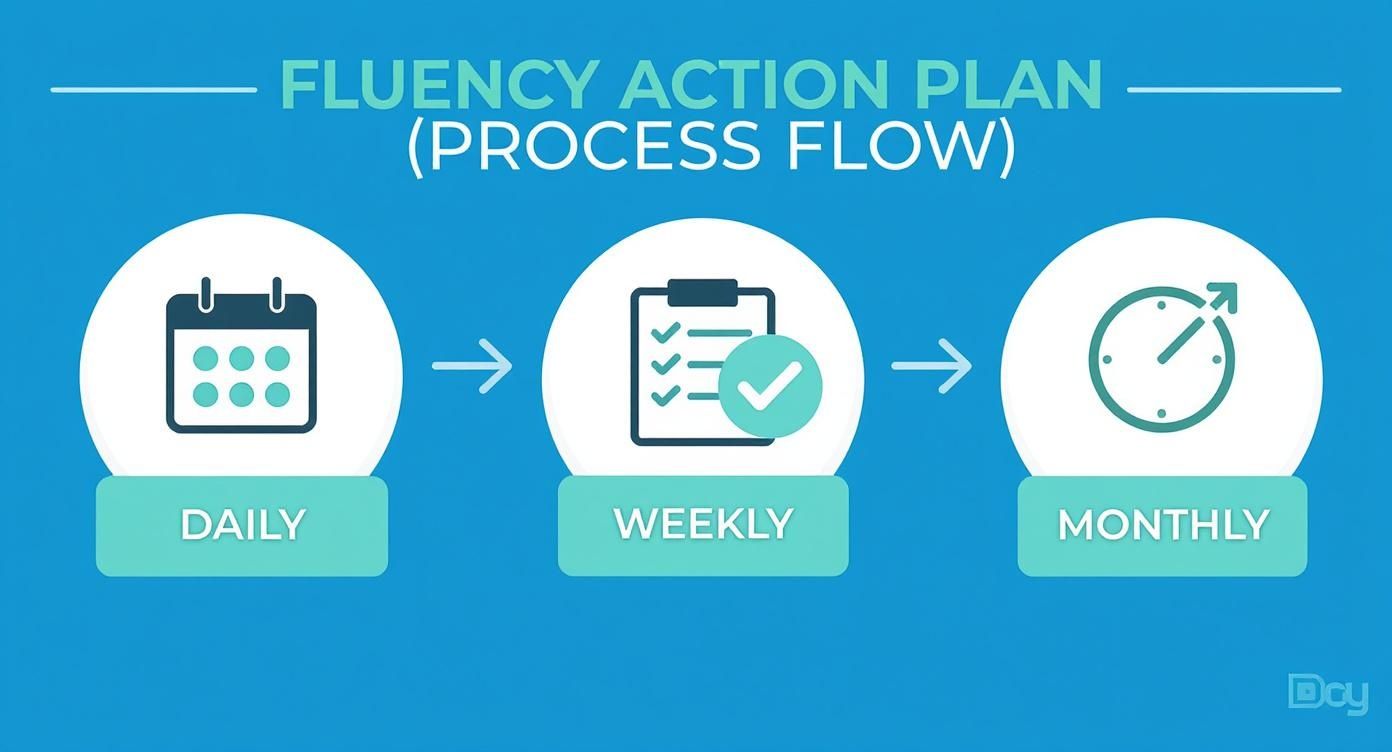how to speak english fluently: quick confidence boosting tip
Feeling like you've hit a plateau on your path to fluent English? It’s a common hurdle. The real secret to the question 'how to speak English fluently' isn’t just about memorising rules; it's about weaving a consistent thread of active immersion, daily speaking practice, and a mindset that values communication over absolute perfection. Let's get into how you can make these habits a natural part of your life.
Your Practical Path to Fluent English
So many learners find themselves stuck in that frustrating gap where textbook knowledge just doesn't seem to click in real-world conversations. This guide is designed to pull you out of endless grammar drills and into methods that actually get you talking. True fluency comes from a structured approach that transforms big, vague goals into small, concrete tasks you can do every day and every week.
Consistency is everything. I've seen it time and again: building small, repeatable habits creates a learning engine that will get you much further than cramming for hours once a month. This plan is all about integrating English into your routine so seamlessly you barely notice it's "study."
Breaking Down Your Fluency Goals
A good journey starts with a good map. Instead of just aiming for the distant land of "fluency," let's break it down into actionable steps you can actually see and measure. Think about what you can realistically commit to daily, weekly, and monthly.
-
Daily Actions: These are your non-negotiables. Just 15-20 minutes of a focused activity—like listening to an English podcast on your commute or even just narrating your daily chores out loud—builds incredible momentum.
-
Weekly Tasks: These require a little more time but are crucial for deepening your skills. Scheduling a weekly chat with a language partner or tackling a short writing exercise helps lock in what you've been learning.
-
Monthly Milestones: These are your mini-celebrations. It could be something like delivering a short presentation at work in English or finally watching an entire movie without subtitles and actually following the plot.
This visual flow shows how you can structure your efforts.
As the infographic highlights, it’s the small, daily efforts that stack up into bigger weekly wins and, eventually, major monthly breakthroughs. This creates a sustainable, motivating cycle that keeps you moving forward.
The Mindset for Success
Your attitude towards learning is just as critical as the methods you use. You have to embrace a mindset of communication over perfection. Every mistake isn't a failure; it’s just feedback showing you what to work on next. This practical, growth-oriented approach is a hallmark of successful students. For those who thrive with more structure, finding the right language school in Singapore can offer the curriculum and expert guidance to build both skills and confidence.
The goal is to be understood, not to be flawless. Shifting your focus from grammatical perfection to effective communication reduces anxiety and encourages you to speak more, which is the fastest way to improve.
Ultimately, language is about connection. When you start to see it less as a subject to be mastered and more as a tool for connection—recognising it as one of the essential soft skills for leaders—your motivation will skyrocket. Fluency doesn't just improve your grammar; it opens up new professional and personal worlds, making you a more effective and empathetic communicator.
To make this even more concrete, here's a simple table to help you structure your week.
Your Fluency Action Plan At a Glance
This quick summary breaks down actionable goals by frequency, helping you build a consistent and powerful learning habit. Just pick one or two from each category to start.
| Frequency | Core Activity | Example Task |
|---|---|---|
| Daily | Active Listening | Listen to a 15-minute English podcast or news broadcast and summarise the main points aloud. |
| Daily | Speaking Practice | Narrate your actions for 5 minutes (e.g., "I'm making coffee now, and I'm adding milk.") |
| Weekly | Conversational Practice | Have a 30-minute video call with a language exchange partner. |
| Weekly | Vocabulary Building | Learn 10 new words related to your job or a hobby and use each one in a sentence. |
| Monthly | Real-World Application | Watch an English-language film without subtitles and write a short review. |
Think of this table not as a rigid set of rules, but as a flexible menu of options. The key is to find what works for you and stick with it. Consistency will always beat intensity in the long run.
Build Your English Immersion Environment
You don't need to move abroad to become fluent. The real secret is to strategically weave English into the fabric of your daily life until it feels completely natural. It's about making small, clever tweaks that turn your home, your phone, and even your thoughts into a dynamic language lab.
Think of it less as a chore and more as a habit you're building. When English is all around you, you absorb it without even trying.
Optimise Your Digital World
Your phone is probably the first thing you look at in the morning, so start there. Switch its language to English. It’s a simple change, but you’ll be surprised how quickly you pick up new vocabulary just from navigating your menus and notifications.
Next, curate your social media feeds. Follow English-speaking influencers, news outlets, and even meme accounts related to your hobbies. Subscribe to a few newsletters or podcasts in English for a quick dose of practice during your commute.
- Device Settings: Change your phone, laptop, and tablet to English.
- Social Feeds: Follow creators and publications that post in English.
- Streaming: Set your favourite streaming service to English audio or subtitles. This trains your listening muscles while you relax.
Create "English-Only" Zones at Home
You can create pockets of immersion right where you live. Designate specific areas or times for English-only activities.
For instance, your kitchen could become a space where you narrate what you're doing. "Okay, now I'm chopping the onions…" It sounds a bit silly at first, but this kind of self-talk is incredibly powerful for building active vocabulary.
- The Kitchen Corner: Narrate your cooking process out loud.
- The Reading Nook: Keep only English books and magazines here.
- The Virtual Cafe: Use one corner of your room for video calls with language exchange partners.
Adopt the "Think in English" Habit
This is a game-changer. Start with just five minutes a day of consciously thinking in English. It could be while you're brushing your teeth or waiting for the bus. What are you seeing? What are you planning to do next?
As it gets easier, stretch that time to ten or fifteen minutes. This mental workout trains your brain to form thoughts directly in English, cutting out the slow, clumsy step of translating from your native language.
The goal is to stop translating and start thinking. Consistent mental rehearsal is the fastest way to build the pathways for spontaneous, natural speech.
Singapore's own journey with English shows just how powerful immersion can be. Since the 1960s, the nation's bilingual policy and English-medium schools have resulted in nearly 80% of the working-age population speaking English proficiently. It proves that a systemic environment works wonders.
If you're looking for speaking partners, check out our guide on finding a language exchange in Singapore.
Set Up Smart Reminders
A few well-placed triggers can keep you on track. Use simple sticky notes to nudge your brain back into "English mode" throughout the day.
- A note on your bathroom mirror: "Greet yourself in English this morning!"
- A recurring calendar alert at 3 PM: "5-Minute English Thought Break."
- Your phone wallpaper could be a new phrase you're trying to memorise.
Turn Entertainment into Active Training
Your downtime is a golden opportunity for learning. Instead of just passively consuming media, engage with it.
Swap your usual playlist for English songs and actually look up the lyrics. When watching a movie, don't just read the subtitles—pause and try to mimic a character's line, paying close attention to their accent and intonation.
- Listen Actively: Jot down new words you hear in a notebook.
- Imitate Scenes: Pause a show and repeat a line of dialogue.
- Discuss What You Watch: Share your thoughts on an episode in an English-speaking online forum.
Keep Track of Your Wins
How do you know you're getting better? You have to track it.
Keep a simple journal to log new words or cool phrases you've learned. Once a week, record yourself speaking for a minute about your day. When you listen back in a month, you'll be amazed at the progress.
Celebrate the small victories—ordering your kopi in fluent English, understanding a joke in a movie, or using a new idiom correctly in a conversation. These moments are what build real, lasting confidence.
A Real-World Example
Let's look at Emma. She swapped her nightly Netflix binge in her native language for an English-language drama. She started picking up three new phrases per episode. She also set a daily phone reminder to journal in English for just five minutes.
Within three weeks, her confidence soared, and she found herself making fewer grammatical mistakes.
"I barely even notice the effort anymore," Emma told us. "English just feels like a normal part of my day."
Her small, consistent changes made all the difference.
Your Next Steps
Ready to get started? Don't try to do everything at once.
- Today: Pick one device—your phone is a great start—and switch the language to English.
- This Week: Commit to five minutes of thinking in English every morning before you start your day.
- Every Sunday: Spend ten minutes reviewing your progress journal. What worked? What didn't? Adjust one habit for the week ahead.
Fluency isn't built in a day. It grows when practice becomes so integrated into your routine that it feels seamless. Design your environment for success, and you’ll see your English skills flourish.
Daily Drills for Active Speaking and Listening
Knowing English grammar and vocabulary is one thing, but using it in a real conversation without stumbling? That’s a completely different ball game. To get from just knowing the language to actually using it, you need to build muscle memory. It’s all about daily, dedicated practice.
Let’s dive into some powerful speaking and listening exercises you can weave into your daily routine. These aren’t tedious homework assignments; they're clever drills you can do anywhere, turning dead time into real progress. The goal is to train your brain to think and speak in English on the fly, which is the very heart of fluency.
Master Rhythm and Intonation with Shadowing
If you've ever wanted to sound less like you're reading from a textbook and more like a native speaker, shadowing is your secret weapon. The idea is simple: you listen to a native English speaker and repeat what they say almost instantly, like their shadow.
You're not just copying the words. You’re mimicking the entire "music" of the language—the rhythm, the pitch, the pauses. Start with a short audio clip from a podcast or even a YouTube video. Play it, and try to speak along just a split second behind the speaker. Don't stress about catching every single word. The real win is matching their flow and intonation.
This exercise is incredibly physical. It literally trains your mouth, tongue, and vocal cords to produce English sounds more naturally. Stick with it, and you'll find these patterns start showing up in your own speech, making you sound far smoother. For more ideas, exploring proven techniques for English speaking practice can give you even more tools for your daily routine.
Turn Your Thoughts into Words with Self-Narration
One of the biggest hurdles for any language learner is the constant mental translation from your native language to English. Self-narration is a fantastic way to break that habit for good. All you do is describe your actions, your surroundings, or even your thoughts out loud, in English, as you go about your day.
Making breakfast? Say it. "Okay, I'm getting the eggs out of the fridge. Now I'm cracking them into the bowl." It feels a bit silly at first, but it forces you to think directly in English, right in the moment. You're actively pulling up vocabulary you need, right when you need it.
Self-narration transforms everyday activities into live speaking practice. It builds the crucial skill of forming sentences spontaneously without the pressure of a real conversation.
The beauty of this is its flexibility. You can do it for five minutes while getting dressed or for a whole hour during a walk. It’s a low-stakes, high-reward way to make speaking English a constant, active part of your life.
Become Your Own Pronunciation Coach
Your smartphone is probably the most powerful language tool you own, and you might not even realise it. The voice recorder app is all you need to become your own pronunciation coach. This simple drill gives you the honest feedback you need by showing you the gap between how you think you sound and how you actually sound.
Try this simple routine:
- Find a short text: Grab a paragraph from a news article, a blog post, or a book.
- Record yourself reading it: Speak clearly and at a normal, conversational pace.
- Listen and compare: Now, find an audio version of that text (an audiobook snippet or a text-to-speech tool works great). Listen to the native speaker, and then listen back to your own recording. Pay close attention to the differences in pronunciation, stress, and intonation.
- Isolate and correct: Did you struggle with a particular sound or word? Practise that specific bit a few times, then try re-recording the whole passage.
This loop of recording, comparing, and correcting is one of the fastest ways to polish your accent and iron out those stubborn pronunciation mistakes.
Develop Active Listening Skills
Fluency is a two-way street. It’s not just about speaking; it's about understanding what’s being said to you. Most learners are passive listeners—they catch just enough keywords to get the general idea. To really level up, you need to practise active listening, which means engaging your brain and truly processing the information.
A great way to do this is the "podcast summary" drill. Pop on a five-minute segment of an English podcast on a topic you find interesting. When it's over, pause and summarise the key points out loud. Ask yourself:
- What was the main point the speaker was trying to make?
- What specific details or examples did they use to back it up?
- What was the overall tone—was it serious, funny, or informative?
This drill pushes you beyond just hearing words; it forces you to understand meaning. It sharpens your comprehension, exposes you to new vocabulary, and—bonus—gives you more speaking practice! For those who become really proficient, there are even online tutoring opportunities where you can help others while continuing to hone your own skills.
By making these drills a consistent part of your day, you’ll be building the confidence and mental reflexes you need for those smooth, natural conversations you’ve been working towards.
Navigating Real-World Conversations with Confidence
All the theory and daily drills are great, but the real test? That happens when you’re face-to-face with someone, trying to have a real conversation. This is where practice meets reality. The goal isn't to deliver a flawless monologue; it's to jump into the messy, dynamic back-and-forth that makes up genuine human interaction.
Stepping into these real-world scenarios can feel pretty intimidating, I know. But a few strategic tools can make a world of difference. It's really about learning to manage the flow, handle those "uh-oh" moments gracefully, and shifting your focus from perfect grammar to genuine connection.
Go with the Flow of Natural Conversation
Listen closely to a fluent speaker. You'll notice they rarely speak in perfectly polished, textbook sentences. Their speech is peppered with little words and phrases that buy them thinking time, show they haven't finished their thought, or just make their language sound a bit softer and more natural. Learning to weave these into your own speech is a game-changer for sounding more authentic.
Start by getting comfortable with "filler words." Things like "well," "you know," "actually," and "I mean" can give you a precious second to gather your thoughts without that dreaded awkward silence. They're like little bridges in your speech, keeping everything moving smoothly.
Handling Those Moments of Panic
It happens to all of us, even native speakers. You're halfway through a sentence, and poof—the perfect word completely vanishes from your mind. The natural instinct is to freeze up. But the real secret to confident speaking is learning how to cruise right through these moments without breaking your stride.
Instead of stopping cold, try one of these recovery tricks:
- Paraphrase it. Just describe the word you're searching for. Can't remember "architect"? Try saying, "you know, the person who designs buildings."
- Ask for a hand. It’s completely okay to say, "What's that word I'm looking for? It's a thing you use to…" Most people are more than happy to help you out.
- Use a simpler word. Don't let the hunt for a fancy vocabulary word derail your entire point. Grab a more basic term and keep the conversation rolling. Communication is the goal, not a vocabulary quiz.
The most confident speakers aren't the ones who never forget a word; they're the ones who know how to recover gracefully when they do. This skill alone will do wonders for your speaking anxiety.
This focus on getting the message across—over perfect grammar—is why some learning environments are so successful. Just look at Singapore, which consistently ranks among the top countries for English proficiency. In the 2023 EF English Proficiency Index, it held the 2nd position globally out of 113 countries. This success comes from a culture of using English as a practical, everyday tool where clarity and connection are the top priorities. You can read more about Singapore's top English proficiency rankings and see how this pragmatic approach works.
Building Your Toolkit of Go-To Phrases
Having a mental list of ready-to-use phrases is like having a conversational safety net. It helps you enter, navigate, and exit discussions with much more ease. Think of these as your personal toolkit, ready to be deployed whenever you need them.
Conversation Starters and Keepers
Try memorising a few simple phrases that work in different settings to get a conversation going and keep it alive.
| Situation | Example Phrases |
|---|---|
| Joining a group | "Mind if I join you?" or "Hi, I'm [Your Name]. What a great event." |
| Asking for opinions | "What do you think about…?" or "I was just wondering your take on…" |
| Showing agreement | "That's a great point." or "I completely agree with you on that." |
| Politely disagreeing | "I see what you mean, but I have a slightly different view." |
These phrases do more than just help you speak; they signal that you're an active, engaged listener—the foundation of any good chat. Start by picking one or two from each category until they feel natural. Before you know it, you'll be using them without a second thought, giving you the confidence to handle any conversation that comes your way.
Advanced Techniques to Sound More Natural
Getting your grammar right is a huge milestone, but the real magic happens when you move from technically correct sentences to natural, flowing speech. This is the leap that separates someone who *knows* English from someone who truly *speaks* it.
It’s about capturing those subtle details native speakers use without even thinking. Many learners get bogged down memorising single vocabulary words, but the secret often lies in how those words team up.
Master Word Partnerships with Collocations
Ever wonder why we say "fast food" but never "quick food"? Or "make a decision" instead of "do a decision"? These natural word pairings are called collocations, and they are one of the best shortcuts to sounding authentic.
When you learn these word chunks, you give your brain a massive head start. Instead of just learning the word “mistake,” learn the whole phrase: "make a mistake.” Got the word “attention”? Make it “pay attention.”
Your brain can then pull out these ready-made phrases instantly, which makes you sound smoother and more confident.
- Here's something you can do today: Start a "collocation journal." Whenever you learn a new noun, look up the verbs that commonly go with it. Take "opportunity," for example. You’ll quickly find powerful pairings like seize an opportunity, get an opportunity, or miss an opportunity.
Unlock Culture with Idioms and Phrasal Verbs
If you really want to get to the heart of English, you have to embrace its colourful, everyday expressions. Idioms and phrasal verbs are everywhere, from your favourite Netflix show to casual chats at work.
Ignoring them is like watching a film in black and white—you get the plot, but you miss all the flavour.
Phrasal verbs like "give up" (quit) or "look after" (take care of) can feel a bit random because the meaning isn't always obvious. The same goes for idioms like "bite the bullet" (face a tough situation with courage), which add a rich layer of cultural meaning.
The goal isn’t to memorise a giant list of idioms. It's about learning to spot them in the wild. When you hear one in a podcast or read one in an article, pause and figure it out from the context.
A fun way to practise this is by watching popular sitcoms like Friends or The Office. They are packed with the kind of language people actually use. When a character says something you don't recognise, jot it down and try to use it yourself later that day. It makes the learning active and helps the phrases stick.
Find the Music in English Rhythm and Intonation
Fluency isn’t just about the words you choose; it’s about how you say them. The rhythm, stress, and intonation—what I like to call the "music" of English—are what make you sound engaging and easy to understand.
Without the right intonation, even a perfect sentence can fall flat or, worse, be misunderstood.
Just think about the simple question, "You're coming to the party?"
- If your voice goes up at the end, you're genuinely asking.
- If your voice goes down, it sounds more like a statement you believe to be true.
That's the power of intonation. It carries so much emotion and meaning. Sentence stress is just as vital. In English, we don't give every word equal weight. We emphasise the important "content" words (like nouns and main verbs) and glide over the small "function" words (like 'a', 'the', 'to').
For instance, a native speaker would naturally say: "I went to the store to buy some milk."
This creates that distinct English rhythm. A great way to get a feel for this is to go back to the shadowing technique. This time, don’t worry so much about the words—just mimic the speaker's melody. Exaggerate the highs and lows. It feels a bit silly at first, but it’s a brilliant way to train your mouth and your ear to find the natural rhythm of the language.
Got Questions About English Fluency? We've Got Answers
As you start getting serious about fluency, it’s only natural for questions and doubts to creep in. In fact, it's a good sign—it means you're engaged in the process.
Let's walk through some of the most common hurdles learners run into. Getting these sorted will help you manage your own expectations and keep your strategy sharp.
How Long Does It Really Take to Speak English Fluently?
Ah, the million-dollar question. The honest truth? There's no single answer. Your journey to fluency is uniquely yours, shaped by your starting point, how much time you put in, and how you immerse yourself in the language. Think of it more like a marathon than a sprint.
Someone who commits to an hour of focused, active practice every day can often reach a solid conversational level in about 6 to 12 months. But genuine fluency—where you can articulate complex ideas without a second thought—is a goal even native speakers are always refining.
Forget chasing some imaginary finish line. The best approach is to build daily habits you can stick with. Celebrate the small victories, like finally understanding a tricky idiom or having a five-minute chat without getting stuck. Progress isn't always linear, so consistency is your best friend.
What's the Best Way to Practise Speaking if I Don't Have a Partner?
This is a big one. Many people think they need a conversation partner to improve, but that's not true at all. You can make huge progress on your own.
Some of the most powerful speaking drills are solo exercises. They build the muscle memory and confidence you need for when you do talk to someone. Try these:
- Narrate Your Life: As you go about your day, describe what you're doing out loud in English. "I'm pouring a cup of tea now, and I'm adding a bit of milk." It might feel odd at first, but it's an incredible way to train your brain to think directly in English.
- Record Yourself: Pick a topic you know well and talk about it for two minutes. Record it on your phone, then play it back. You'll be amazed at what you notice about your pronunciation, word choice, and flow when you're just listening.
- Try "Shadowing": Find a short audio clip of a native speaker and try to speak along with them in real-time, matching their rhythm and intonation. This is a fantastic exercise for sounding more natural.
How Do I Get Over My Fear of Making Mistakes?
If there's one thing that holds learners back, it's the fear of messing up. The secret is to reframe your goal. You're not aiming for perfection; you're aiming for communication.
Every single mistake is just a piece of feedback. It’s not a failure; it’s a signpost showing you what to focus on next.
Start small, in situations with low stakes. Ordering your coffee or asking a shop assistant for help are perfect opportunities. You'll quickly realise most people are happy to help someone who is learning.
And when you do slip up? If you can correct it easily, great. If not, just let it go and keep the conversation moving. Being understood is the real prize, and a few little grammar errors almost never get in the way of that.
Should I Learn British or American English?
Honestly, for most learners, this isn't as big a deal as it seems. The most practical advice is to just pick one and be consistent with it, at least in the beginning. This helps avoid getting tangled up in different vocabulary ('lift' vs. 'elevator') or spelling ('colour' vs. 'color').
So, how do you choose? Let these points guide you:
- Your Exposure: Which accent do you hear most in the podcasts you listen to or the shows you watch? Go with what feels familiar.
- Your Resources: Are your learning materials already geared towards one or the other? Stick with that.
- Your Gut Feeling: Which one just sounds better to your ear? Sometimes it's as simple as that.
At the end of the day, both are understood all over the world. As long as you're communicating clearly and effectively, you're winning.
Ready to fast-track your journey to fluency with expert guidance? Spanish Council Singapore offers personalised and results-driven courses that combine conversational practice, cultural immersion, and a structured curriculum. Whether you're a beginner or preparing for exams, our native, certified teachers can help you achieve your language goals.
















